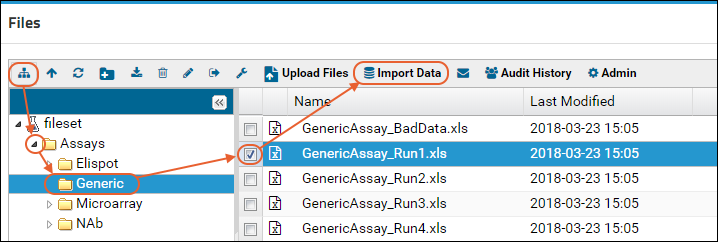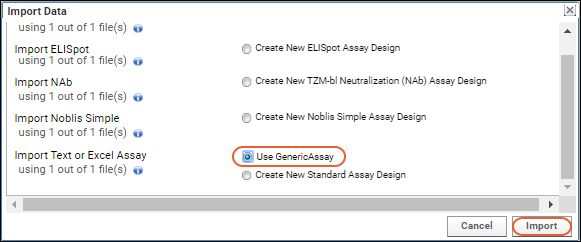Import Assay Runs |
2024-04-18 |
The import process for instrument data using an assay design involves some steps that are consistent for all types of assays. The process can vary a bit depending on the the type of assay and features enabled. This topic covers the common steps for importing assay data.

 Explore the runs grid in this topic:
Explore the runs grid in this topic:
- Create an Assay Design
- Upload Data Files to LabKey Server
- Import Data into an Assay
- Assay Event Logging
- Assay Data and Original Files
Create an Assay Design
Before you import data into an assay design, you need a target assay design in your project. An assay design will correctly map the instrument data to how it will appear on the server.If you don't already have an assay design in your project, an administrator or assay designer can create one following one of these processes. Only Admins and users with the "Assay Designer" role can design assays.- Create a new assay design from scratch
- Infer a design using the contents of the first run
- Import a pre-existing assay design
Upload Data Files to LabKey Server
- Add the Files web part to your assay project if it is not present already
- OR
- Select (Admin) > Go To Module > FileContent.
- Upload your data files into the Files web part. See Using the Files Repository for details.
Consider File Naming Conventions
Before uploading data files, consider how your files are named, in order to take advantage of LabKey Server's file grouping feature.When you import data files into an assay design, LabKey Server tries to group together files that have the same name (but different file extensions). For example, if you are importing an assay data file named MyAssayRun1.csv, LabKey will group it together with other files (such as JPEGs, CQ files, metadata files, etc.), provided they have the same base name "MyAssayRun1" as the data record file.Files grouped together in this way will be rendered together in the graphical flow chart (see below) and they can be exported together as a zip file.Import Data into an Assay
- In the Files web part, navigate to and select the files you want to import.
- Click Import Data.
- In the popup dialog, select the target assay design and click Import.
Enter Batch Properties
You are now on the page titled Data Import: Batch Properties. A batch is a group of runs, and batch properties will be used as metadata for all runs imported as part of this group. You can define which batch properties appear on this page when you design a new assay.- Enter any assay-specific properties for the batch.
- Click Next.
Enter Run-Specific Properties and Import Data
The next set of properties are collected per-run, and while there are some commonalities, they can vary widely by type of assay, so please see the pages appropriate for your instrument. Review run-specific properties and documentation for importing data appropriate for your assay type:- Enter run-specific properties and specify the file(s) containing the data.
- For some types of instrument data, there will be a Next link, followed by an additional page (or more) of properties to enter.
- Click Save and Finish (or Save and Import Another Run if you selected additional files) to initiate the actual import.
Assay Event Logging
When you import an assay run, two new assay events are created:- Assay Data Loaded: This event records the new run you imported.
- Added to Run Group: The new run is added to the batch with other runs in the same import.